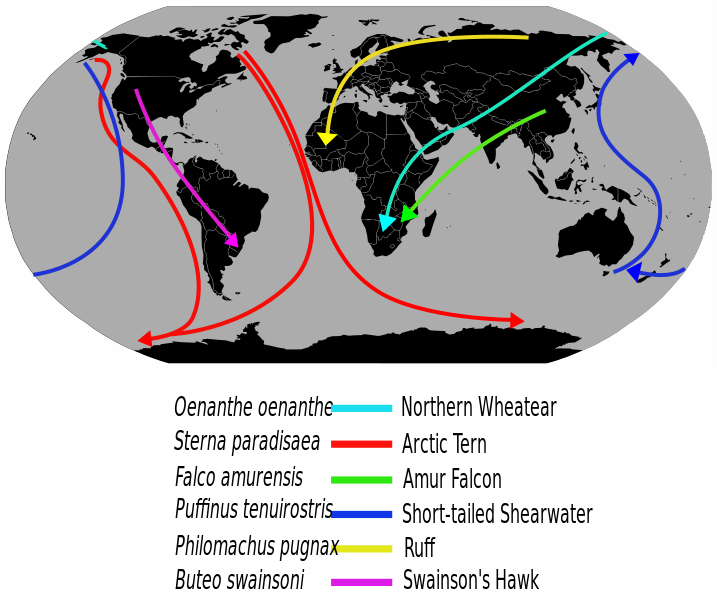Listen to Episode 187 on PodBean, YouTube, Spotify, or wherever you listen to your favorite podcasts!
Among the most spectacular of animal behaviors is the tendency of many species to undertake massive journeys across land, sea, and sky to access the resources they need. This episode, we discuss the diversity and difficulties of Migration.
In the news
Southern Giant Crab is a new fossil species from Miocene New Zealand
The oldest fossil forest reported from England
Well-preserved early cephalopods from Cambrian Queensland
A mating pair of termites preserved in Baltic amber
Life On the Move
The word migration brings to mind the mass movements of birds flying south for the winter, or herds of wildebeest trekking across the Serengeti, or lone white sharks swimming from sea to sea. These migratory movements bring animals on journeys far beyond their day-to-day movements, typically in search of food or breeding grounds that they can’t access year-round.

Bottom: Mass movement of Mexican free-tailed bats. Image by Nick Hristov
(Side note: The word migration is also commonly used to refer to changes in a species’ range, such as when warming climates allow plants to spread farther north, or when continental connections allow animals to spread to new areas, but that’s a broader topic for another episode. Also, migration is used to refer to the movements of people from one nation to another, and that’s a topic for another podcast!)
Migration is a behavior that is difficult to define, mainly because animal movements are so incredibly diverse. Many animals migrate seasonally, making round trips every year between food-rich locales or breeding grounds, while other species migrate only from time to time when conditions call for it. Some migrations are short trips, while others cover thousands of kilometers. Many animals migrate on their own, while some of the most incredible migrations on Earth involve thousands to millions of individuals moving together.

Right: Some animals make only a partial migration! Monarch butterflies migrate thousands of kilometers, but it takes multiple generations to do it. Image by C. Formanski.
Migration as a behavior seems to have evolved over and over again in nearly every major group of animals. In some species, only certain populations migrate, or only certain individuals, and many migratory species have non-migratory close relatives.

Evidence of migratory behavior in fossil species is difficult to come by, but not impossible. Stable isotope analysis is a common source of evidence for migration. Different forms (isotopes) of certain elements (including Strontium, Oxygen, and Carbon) are taken up by animals as they eat and drink; the particular ratios of isotopes will vary by habitat, and those ratios will be recorded in animals’ bones and teeth. The most famous such studies involve mammoths, whose tusks record an entire lifetime of changing diets and changing habitats, which can reveal long-distance movements the animals made during their lives. Similar evidence of long-distance movement – possibly seasonal migrations – has been reported from the teeth of certain dinosaur species. This type of isotope analysis is also used to identify long-distance movements of humans at archaeological sites.

Learn More
Serengeti’s ‘breathtaking’ mammal migration shaped by grazers’ diets (non-technical)
Dragonflies Embark on an Epic, Multi-Generational Migration Each Year (non-technical)
Nature’s Most Impressive Animal Migrations (non-technical)
What Is Migration? (technical, open access)
Longest terrestrial migrations and movements around the world (technical, open access)
How Migrants Get There: Migratory Performance and Orientation (technical, open access)
Migratory coupling between predators and prey (technical, paywall)
Isotopes reveal the journey of a woolly mammoth (non-technical)
Possible dinosaur migration inferred from stomach stones (non-technical)
Polar dinosaurs on parade: a review of dinosaur migration (technical, open access)
Strontium isotopes reveal evidence of migratory behaviour in hadrosaurs (technical, open access)
__
If you enjoyed this topic and want more like it, check out these related episodes:
- Episode 43 – The Great American Biotic Interchange (GABI)
- Episode 61 – Behavior in the Fossil Record
- Episode 118 – Trace Fossils
We also invite you to follow us on Twitter, Facebook, or Instagram, buy merch at our Zazzle store, join our Discord server, or consider supporting us with a one-time PayPal donation or on Patreon to get bonus recordings and other goodies!
Please feel free to contact us with comments, questions, or topic suggestions, and to rate and review us on iTunes.